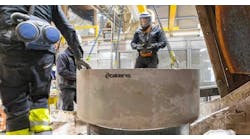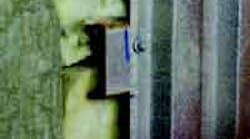Mineral wool board meeting ASTM C-612 class IVB and fiberglass insulation board, in use together.
Mineral wool board meeting ASTM C-612 Class V insulation
A removable ceramic-fiber blanket insulation manufactured for burner fronts
Burner front with ceramic-fiber removable blanket insulation installed.
There are many types of insulation being used in the foundry industry, and the most commonly used materials are mineral wool boards and blankets, calcium silicate blocks, high-temperature mineral wool boards, fiberglass boards and blankets, and ceramic fiber boards and blankets. Metalcasters need cost-effective insulation systems that are installed correctly and thermally efficient. Understanding the differences or similarities of insulation materials can help a foundry to save money — and still meet the operation's thermal requirements. The first step in choosing insulation, and to ensure proper insulation design and installation, is to understand thermal calculations. Following are some important facts about to understand about thermal calculations:
Choosing an insulation material
As you can see by the above formula, the thermal conductivity of the insulation, or the k value, is very important. The k value is established by your choice of insulation and is taken from the thermal conductivity charts provided by the insulation manufactures. The values shown on the thermal conductivity charts are always based on mean temperatures. The mean temperature is the sum total of the operating temperature plus the desired surface temperature, all divided by 2.
K-values shown are approximate and taken from charts provided in manufacturers' brochures and literature.
Mean temperature =The temperatures found inside a foundry vary from 150°F to 1,000°F. This is the reason it is so important for foundry personnel to be aware of the differences or similarities of insulation materials at specific temperatures, especially if past selections were based solely on thickness and kvalue. (See Chart 1.)
Chart 1
Type of Insulation Material | Mean temperature (700F+130F)/2 | Thermal conductivity value (K) 8#, 6#, 4# | Mean temperature (1100F+130F) /2 | Thermal conductivity value (K) 8#, 6#, 4# | Mean temperature (1200F+130F)/ 2 | Thermal conductivity value (K) 8 in., 6 in., 4 in. |
Ceramic fiber blanket 8 in. | 415°F | 0.45, 0.47, 0.50 | 615°F | 0.58, 0.60, 0.70 | 665°F | 0.60, 0.63, 0.75 |
Mineral Wool Board 8 in. ASTM c-612 class 4 | 415°F | .43, 0.45, 0.52 | 615°F | 0.60, 0.66, 0.80 | 665°F | 0.62, 0.68, 0.83 |
Mineral Wool Board ASTM c-612 class 5 | 415°F | 0.44, na, na (10 in. density) | 615°F | 0.59, na, na (10 in. density) | 665°F | 0.63, na, na (10 in. density) |
Calcium Silicate Block ASTM c-533 | 415°F | 0.47, na, na (10 in. density) | 615°F | 0.61, na, na (10 in. density) | 665°F | 0.65, na, na (10 in. density) |
Fiberglass board ASTM c-612 | 415°F | na, na, 0.48 (less than 3 in.) | 615°F | na, na, 0.70 (less than 3 in.) | 665°F | na, na, 0.75 (less than 3 in.) |
Sample Insulation Thickness Calibration: Mineral-wool board
Mean temperature = (operating temperature + surface temperature)/2= °F
415
Type of insulation being used = Mineral-wool board ASTM C-612 class 4, nominal 8-in. density
K value of the insulation based on the mean temperature = (BTU-in./hr.-ft2-°F)
0.43
Operating temp. - surface temp. = °F
570
Convection = (1+.225*velocity fps*(surface temp.-ambient temp.) =
59.375
Radiation =(0.1714* emissivity)*((surface temp. + 460) to the 4th power)/100,000,000-(ambient temp. + 460) to the 4th power)/100,000,000) =
3.0975
3.88
Insulation thickness required = (inches)
4
By changing the type of insulation to a ceramic fiber board (see sample calibration below) the calibrated required thickness is almost the same:
Sample Insulation Thickness Calibration: Ceramic fiber board or blanket
Mean temperature = (operating temperature + surface temperature)/2= °F
415
Insulation used = ceramic-fiber blanket, 8-in. density.
K value of the insulation, based on the mean temperature = (BTU-in./hr.-ft2-°F)
0.45
Operating temp. - surface temp. = °F
570
Convection = (1+.225*velocity fps*(surface temp.-ambient temp.) =
59.375
Radiation =(0.1714* emissivity)*((surface temp. + 460) to the 4th power)/100,000,000-(ambient temp. + 460) to the 4th power)/100,000,000) =
3.0975
4.11
Insulation thickness used = (inches)
4
The chart above represents kvalues of the most common insulation types, drawn from information published by the manufacturers.
Thus, based on a surface temperature of 130°F and an exit gas temperature from the furnace to a heat recovery system of 700°F, the mean temperature would be 415°F (see See Chart 1.) So, no matter what type of material or density you choose, the thermal calculation will give you roughly the same insulation thickness requirement.
As an example, compare mineral wool board and ceramic fiber blanket insulation for thickness requirements. We will base the calibration on the following design conditions and assume the area is a flat surface:
- Ambient air: 80°F
- External wind velocity: 50 fpm
- Surface temperature: 130°F
- Emittance factor of: 0.05 for aluminum lagging
- Operating gas temperature: 700°F
- Insulation type: Mineral wool, 8 in./ft3 board, meeting ASTM C-612 type IV versus ceramic-fiber blanket 8#/cf
This is a demonstration for the reason R. L. Schneider, a pioneer in heat transfer calculations, wrote, "... since it is harder to keep improving insulation by decreasing the k (thermal conductivity), let's increase the thickness when necessary."
So if the k-values of the insulation are about the same then we must look at the difference in the materials themselves, and their impact on material and labor costs to determine the proper material selection.
Material advantages, disadvantages
Calcium silicate block (meeting ASTM c-533)
Advantages
- Provides a hard load-bearing surface
- High temperature limit of 1,200°F
Disadvantages
- It's fragile, and there is excessive breakage during the installation.
- Installation is labor-intensive because band saws and hand saws are needed to cut the block, and the block must be drilled if installing insulation attachments (i.e. acoustical hangers).
- In most applications, lacing wire is needed to hold the insulation in place.
- It is a heavy material (approx. 1 lb/in. of thickness per square foot).
- Once heated, it tends to fracture and often falls apart when the outer lagging or casing is removed.
- Will readily absorb moisture that could accelerate corrosion on any metal that it contacts.
- Limited manufacturing in the United States.
- Has been classified as carcinogenic due to airborne fibers that contain crystalline silica dust, produced when handling and cutting the insulation.
- 2 in. thick is the maximum available as a single layer.
- Installation costs approximately $1.20/board-foot and $6.75/ft2 (1 in. thick), using acoustical hangers and lacing wire, at $50/hour.*
Mineral wool board (8 in./ft3; ASTM c-612 class 4 )
Advantages
- It does not break easily. ? It can be cut easily with a knife, reducing labor cost.
- Lightweight (approx. 0.85 lb per inch of thickness per square foot)
- Flexibility, it conforms to irregular surfaces.
- It can be impaled on insulation pins and held in place with insulation speed clips.
- Installation costs approximately $0.20/board-foot and
- $2.90/ft2 (1 in. thick), using insulation pins and speed clips, at $50/hour.*
Disadvantages
- Has little or no load-bearing capability.
- Once heated, it loses its water-resistance
- Loses its binder when exposed to heat above 450°F
- Presents a potential health hazard and requires special handling due to airborne fibers that may cause skin and upper respiratory irritation
- Loses binder and fiber when exposed to high vibrations
* Installation cost estimates do not account for other factors that affect overall labor cost, such as stiffener sizes, casing configurations, and the lagging application.
Mineral wool board (1,900°F; meeting ASTM c-612 class 5; Fibrex FBX 19K, or equivalent)
|Advantages
- Durability, it does not break easily.
- It can be cut easily with a knife, reducing labor cost.
- It can be impaled on insulation pins and held in place with insulation speed clips.
- It provides a hard, load-bearing surface, especially for walking surfaces.
Disadvantages
- Once heated, it loses its water-resistance.
- It loses its binder when exposed to heat above 450°F
- It presents a potential health hazard, and requires special handling due to the airborne fibers that may cause skin and upper respiratory irritation.
- It loses binder and fiber when exposed to high vibrations.
- It's heavy (approximately 2 lb/in./ft2)
- Material costs approximately $1.00 per board foot and $2.90* per square foot (1 in. thick) to install, using insulation pins and speed clips, at $50/hour.*
Fiberglass board (less than 3 in./ft3 ; Knauf ET board or equivalent)
Advantages
- It does not break easily.
- It can be cut easily with a knife, reducing labor cost.
- Lightweight (approximately 0.45 lb/in./ft2).
- Some flexibility to conform to irregular surfaces.
- It can be impaled on insulation pins and held in place with insulation speed clips.
- Fibers strands are long and less likely to slump or sag when exposed to high vibration.
- Installation costs approximately $0.25/board foot and $2.90/ft2 (1 in. thick), using insulation pins and speed clips, at $50/hour.*
Disadvantages
- Has no load-bearing capability.
- Once heated, it loses its water-resistance.
- Presents potential health risks, and requires special handling due to airborne fibers that may cause skin irritation.
- Has a higher shrinkage rate than other materials at elevated temperatures.
- Recommended for use only up 850°F.
Ceramic Fiber Blanket (8 in./ft3)
Advantages
- It does not break easily.
- It can be cut easily with a knife, reducing labor cost.
- It has some flexibility to conform to irregular surfaces
- It can be impaled on insulation pins and held in place with insulation speed clips.
Disadvantages
- Has no load-bearing capability.
- Once heated, it loses its water-resistance.
- It loses its binder when exposed to heat above 450°F
- It has been classified as carcinogenic due to airborne fibers containing crystalline silica dust
- It loses its binder and fiber when exposed to high vibrations.
- Installation costs approximately $2.50/board-foot and $2.90/ft2, using insulation pins and speed clips, at $50/hour.*
A little knowledge pays off
Understanding the differences or similarities of insulation materials can help save money and still meet your thermal requirements. A greater understanding of the insulation materials that you choose will ensure that you get the right material type for your application method and area to be insulated. Choosing the correct material type based on application will help to keep initial installation costs down.
Foundries need cost-effective insulation systems that are installed correctly and thermally efficient. According to John F. Malloy, author of Thermal Insulation, "Thermal insulation installed to save energy also saves money at the rate that is essential for efficient plant operation."
Gary Bases, author of "The Bril Book" (a guide to brick, refractory, insulation, & lagging systems), is president of BRIL inc., an independent consulting firm specializing in energy saving solutions. Contact him at Tel.330-665-2931 or by email at [email protected].









